Are you in need of a residential roof replacement? Wondering about the cost, process, and benefits it can bring to your home? Look no further! In this comprehensive guide, we will explore how a residential roof replacement can elevate your home in terms of value, aesthetics, and functionality.
When it comes to roof replacements, many homeowners search for “roof replacements near me” to find local contractors who can provide professional services. We understand the importance of finding a reliable and trustworthy roofing contractor in your area to ensure a smooth and successful roof replacement project.
So, if you’re ready to learn about the benefits of a residential roof replacement and discover how it can elevate your home to new heights, let’s dive right in!
How a Roof Replacement Can Improve Overall Home Value and Aesthetics?
1. Enhancing Home Value
1.1 Curb appeal and first impressions:
The roof is one of the first things people notice about a home. A new roof instantly enhances the curb appeal, making your home more attractive to potential buyers if you decide to sell in the future.
1.2 Increased market value:
A roof replacement is considered a significant home improvement investment. By upgrading your roof, you can increase the market value of your property, allowing you to recoup a significant portion of the project cost.
2. Improving Aesthetics
2.1 Fresh and modern appearance:
Over time, roofs can become worn, discolored, or have damaged shingles. A roof replacement gives your home a fresh and modern look, instantly improving its overall aesthetics.
2.2 Matching architectural style:
Choosing the right roofing material and design allows you to align your roof with the architectural style of your home. This cohesive look enhances the overall visual appeal and adds to its charm.
3.Creating a Positive Impression
3.1 Attention to detail:
A new roof showcases your commitment to home maintenance and attention to detail. It creates a positive impression on visitors, neighbors, and potential buyers, indicating that your home is well cared for.
3.2 Perception of quality and reliability:
A sturdy and well-installed roof signifies quality craftsmanship and reliability. It instills confidence in the structural integrity of the entire home, which can be a selling point.
4. Energy Efficiency Benefits
4.1 Improved insulation:
During a roof replacement, you have the opportunity to upgrade the insulation, which can enhance energy efficiency. Better insulation helps regulate indoor temperature, reducing reliance on heating and cooling systems.
4.2 Lower energy bills:
With a more energy-efficient roof, you can experience reduced energy consumption and subsequently lower utility bills. This cost-saving benefit adds value to your home and appeals to eco-conscious buyers.
5. Longevity and Peace of Mind
5.1 Extended roof lifespan:
A new roof provides durability and longevity, giving you peace of mind for many years to come. It eliminates the need for constant repairs and maintenance associated with an aging roof.
5. 2 Transferable warranties:
Most reputable roofing contractors offer warranties on their workmanship and materials. This transferable warranty can be a valuable selling point, assuring potential buyers of the roof’s quality and protection.
Potential risks and consequences of neglecting roof issues
Neglecting roof issues can lead to several risks and consequences that homeowners should be aware of:
1. Structural Damage
Roof issues, such as leaks or missing shingles, can allow water to penetrate the roof and damage the underlying structure of the house.
Over time, this can weaken the roof deck, rafters, and even the foundation, potentially leading to costly repairs or compromising the structural integrity of the entire home.
2. Mold and Mildew Growth
Roof leaks or inadequate ventilation can create a moist environment that promotes the growth of mold and mildew.
These microorganisms can spread throughout the home, causing health problems such as allergies, respiratory issues, and even serious infections. Removing mold and mildew can be a costly and time-consuming process.
3. Increased Energy Costs
Roof issues, such as poor insulation or gaps, can result in energy inefficiency. Leaks and drafts allow conditioned air to escape, causing the HVAC system to work harder to maintain desired temperatures. This can lead to increased energy consumption and higher utility bills.
4. Pest Infestations
A damaged roof provides an entry point for pests like rodents, birds, and insects. They can create nests, chew through materials, and cause additional damage to the roof and interior of the home.
Dealing with pest infestations can be inconvenient and require professional intervention to eradicate the pests and repair the damage.
5. Decreased Home Value
Neglected roof issues can significantly decrease the value of a home. When potential buyers see a damaged roof, they may perceive it as a major red flag, leading to lower offers or difficulty in selling the property. A well-maintained roof enhances the curb appeal and marketability of the home.
6. Safety Hazards:
Neglected roof issues can pose safety risks to occupants. Loose or missing shingles can become hazards during storms, potentially causing property damage or injuring individuals nearby. Water leaks can also create slippery surfaces, increasing the risk of accidents and falls.
7. Insurance Coverage Issues:
Neglecting roof maintenance and not addressing known issues can result in insurance coverage complications. Insurers may deny claims for damage resulting from pre-existing roof problems, leaving homeowners responsible for costly repairs or replacements
Finding a Reputable Roofing Contractor
Finding a reputable roofing contractor is the first step in the roof replacement process. Here are some tips to help you find the right professional for the job:
1. Research and gather recommendations:
Ask for recommendations from friends, family, or neighbors who have recently had their roofs replaced. Research online reviews and ratings to get an idea of contractors’ reputation and reliability.
2. Check credentials and certifications:
Ensure that the roofing contractor is licensed, insured, and bonded. Look for certifications from reputable organizations that demonstrate their expertise and commitment to quality workmanship.
3. Request multiple quotes:
Obtain quotes from at least three different roofing contractors. Compare their pricing, services, and warranties to make an informed decision.
4. Ask for references:
Request references from the contractor and take the time to contact previous clients. Inquire about their experience with the contractor, the quality of work performed, and overall satisfaction.
Roof Inspection and Assessment
Once you have chosen a roofing contractor, they will conduct a thorough roof inspection and assessment. This step helps determine the scope of the project and identifies any underlying issues that need to be addressed. The inspection may include:
1. Examination of the roof’s condition:
The contractor will inspect the shingles, flashing, gutters, vents, and other roof components to assess their condition and identify areas of concern.
2. Identifying underlying damage:
The inspection will uncover any hidden damage, such as rot, mold, or structural issues. This information helps in planning the necessary repairs or replacements.
3. Measurement and calculation:
The contractor will measure the roof’s dimensions and calculate the required materials, including shingles, underlayment, and accessories.
Steps Involved in a Roof Replacement Project
The roof replacement process typically includes the following steps:
1. Preparing the work area: The contractor will ensure the surroundings are protected, covering windows, landscaping, and other vulnerable areas to prevent damage.
2. Removing the existing roof: The old roof materials, including shingles, underlayment, and flashing, will be removed to expose the roof deck.
3. Repairing the roof deck: Damaged or rotten sections of the roof deck will be repaired or replaced to ensure a solid foundation for the new roof.
4. Installing underlayment and flashing: A new layer of underlayment, such as asphalt felt or synthetic material, will be installed to provide an additional waterproof barrier. Flashing will also be installed around roof penetrations and valleys to prevent water intrusion.
5. Applying new roofing material: The selected roofing material, such as asphalt shingles, metal panels, or tiles, will be installed according to the manufacturer’s instructions and industry best practices.
6. Ventilation and insulation: Proper ventilation and insulation will be addressed during the roof replacement to ensure energy efficiency and prevent moisture-related issues.
7. Final touches and cleanup: The contractor will perform a thorough cleanup of the work area, removing debris and conducting a final inspection to ensure the roof replacement meets quality standards.
What is the Roof Replacement Cost per Square Foot?
The cost of a roof replacement per square foot can vary depending on various factors such as the location, roofing material, complexity of the project, and contractor rates. It’s important to note that the cost can differ significantly between regions and even within the same area due to labor and material costs.
On average, the cost of a residential roof replacement ranges from $3 to $7 per square foot. This estimate includes the removal of the existing roof, installation of new roofing materials, and associated labor costs. However, it’s essential to obtain detailed quotes from roofing contractors to get an accurate assessment for your specific project.
When considering the cost of a residential roof replacement, it’s crucial to take into account the size of your roof, the type of roofing material you choose (such as asphalt shingles, metal, tile, or slate), any additional features or upgrades (such as skylights or ventilation systems), and the complexity of the project.
Conclusion
In conclusion, a residential roof replacement offers numerous benefits for homeowners. Throughout this blog, we explored various aspects related to roof replacements, including the significance of addressing roof issues promptly, the impact on home value and aesthetics, and the potential risks of neglecting roof problems.
Additionally, we discussed specific concerns such as house roof felt repair services , leak repair, and roof lining repair, as well as the costs associated with replacing the roof of different types of homes like terraced houses and park homes.
About Mr. Roofer
If you’re in need of a residential roof replacement, it’s essential to consider local options by searching for “roof replacements near me.” Connect with Mr.Roofer who provide expert advice, quality workmanship, and competitive pricing. Remember to request multiple quotes, verify credentials, and check customer references before making a decision.
Investing in a roof replacement is an investment in the long-term value and beauty of your home. Don’t overlook the importance of addressing roof issues promptly, as neglecting them can lead to structural damage, increased energy costs, and potential health hazards from mold and mildew growth.
By taking proactive steps to maintain and replace your residential roof, you can enjoy a secure and aesthetically pleasing home that stands the test of time. Don’t wait any longer—consider a residential roof replacement and elevate your home to new heights of beauty, functionality, and value.
The coverage for roof replacements varies depending on your insurance policy and the specific circumstances of the damage. Insurance typically covers roof replacements due to sudden and accidental damage, such as storm damage or fire. However, coverage may be limited for roofs that have reached the end of their expected lifespan. Review your insurance policy or consult with your insurance provider to understand the coverage details.
While roof replacements are more commonly done during milder weather, it is possible to replace a roof during the winter months. However, it may be subject to weather conditions and the specific circumstances of your location. Consult with a roofing contractor to determine if a winter roof replacement is feasible in your area.
The duration of a roof replacement project depends on various factors, including the size and complexity of the roof, weather conditions, and the contractor’s schedule. On average, a residential roof replacement can take anywhere from a few days to a couple of weeks. The roofing contractor can provide a more accurate timeline based on your specific project.
The lifespan of a roof depends on various factors such as the roofing material, climate conditions, and maintenance. Generally, asphalt shingle roofs last around 20-25 years, while metal, tile, and slate roofs can have a longer lifespan of 50 years or more. It’s important to monitor your roof’s condition and consult with a professional to determine if replacement is necessary.

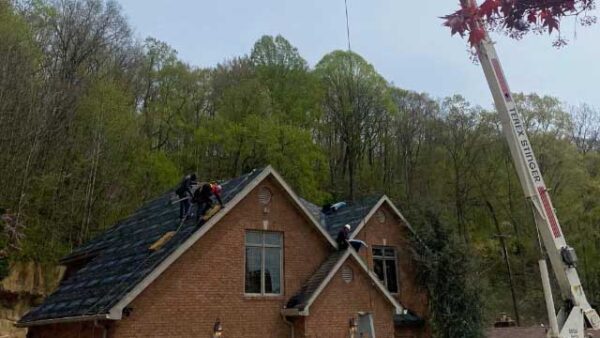

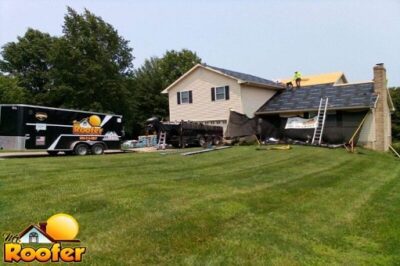
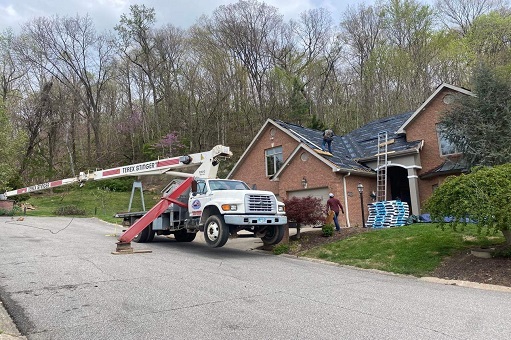
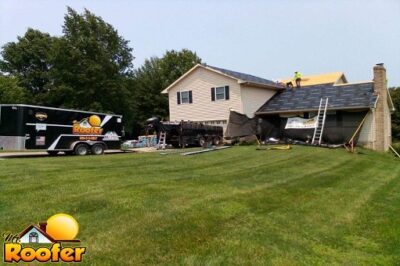
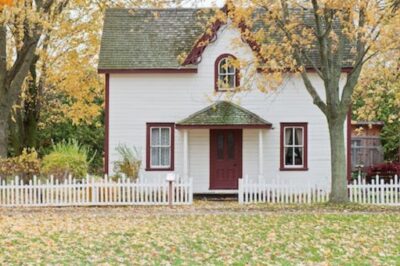
0 Comments